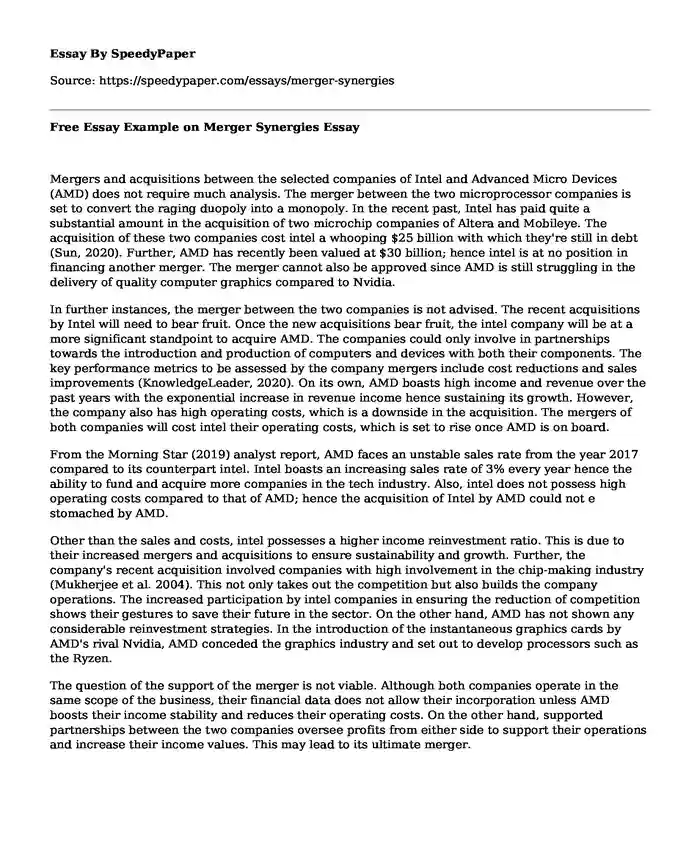
| Type of paper: | Course work |
| Categories: | Company Information technologies Electronics Strategic marketing |
| Pages: | 3 |
| Wordcount: | 711 words |
Mergers and acquisitions between the selected companies of Intel and Advanced Micro Devices (AMD) does not require much analysis. The merger between the two microprocessor companies is set to convert the raging duopoly into a monopoly. In the recent past, Intel has paid quite a substantial amount in the acquisition of two microchip companies of Altera and Mobileye. The acquisition of these two companies cost intel a whooping $25 billion with which they're still in debt (Sun, 2020). Further, AMD has recently been valued at $30 billion; hence intel is at no position in financing another merger. The merger cannot also be approved since AMD is still struggling in the delivery of quality computer graphics compared to Nvidia.
In further instances, the merger between the two companies is not advised. The recent acquisitions by Intel will need to bear fruit. Once the new acquisitions bear fruit, the intel company will be at a more significant standpoint to acquire AMD. The companies could only involve in partnerships towards the introduction and production of computers and devices with both their components. The key performance metrics to be assessed by the company mergers include cost reductions and sales improvements (KnowledgeLeader, 2020). On its own, AMD boasts high income and revenue over the past years with the exponential increase in revenue income hence sustaining its growth. However, the company also has high operating costs, which is a downside in the acquisition. The mergers of both companies will cost intel their operating costs, which is set to rise once AMD is on board.
From the Morning Star (2019) analyst report, AMD faces an unstable sales rate from the year 2017 compared to its counterpart intel. Intel boasts an increasing sales rate of 3% every year hence the ability to fund and acquire more companies in the tech industry. Also, intel does not possess high operating costs compared to that of AMD; hence the acquisition of Intel by AMD could not e stomached by AMD.
Other than the sales and costs, intel possesses a higher income reinvestment ratio. This is due to their increased mergers and acquisitions to ensure sustainability and growth. Further, the company's recent acquisition involved companies with high involvement in the chip-making industry (Mukherjee et al. 2004). This not only takes out the competition but also builds the company operations. The increased participation by intel companies in ensuring the reduction of competition shows their gestures to save their future in the sector. On the other hand, AMD has not shown any considerable reinvestment strategies. In the introduction of the instantaneous graphics cards by AMD's rival Nvidia, AMD conceded the graphics industry and set out to develop processors such as the Ryzen.
The question of the support of the merger is not viable. Although both companies operate in the same scope of the business, their financial data does not allow their incorporation unless AMD boosts their income stability and reduces their operating costs. On the other hand, supported partnerships between the two companies oversee profits from either side to support their operations and increase their income values. This may lead to its ultimate merger.
Conclusion
In general, the rise in the use of technology requires robust workstations and computers. This can assure both companies the endless demand for their products. However, the increased changes and the dynamic nature of technology and the sector requires their avid changes and updates in their methods and machines. Further, the companies may also pay close attention to their financial analysis and gains. The assurance of future business in the industry depends on the strategies set in the present. Company performance is also of the essence, with the focus ratios set as company goals and milestones. This way, the rival companies may come together on allowable financial terms to form a microprocessor monopoly.
References
Inc, A. (2020). Advanced Micro Devices Inc (AMD) Quote | Morningstar. Retrieved 16 February 2020, from https://www.morningstar.com/stocks/xnas/amd/quote
Sun, L. (2020). 5 Reasons Intel Would Never Buy Advanced Micro Devices | The Motley Fool. Retrieved 16 February 2020, from https://www.fool.com/investing/2019/01/20/5-reasons-intel-would-never-buy-advanced-micro-dev.aspx
KnowledgeLeader, P. (2020). Guide to Managing Mergers and Acquisitions KPIs. Retrieved 16 February 2020, from https://info.knowledgeleader.com/guide-to-managing-mergers-and-acquisitions-kpis
Mukherjee, T. K., Kiymaz, H., & Baker, H. K. (2004). Merger motives and target valuation: A survey of evidence from CFOs. Journal of Applied Finance, 14(2).
Cite this page
Free Essay Example on Merger Synergies. (2023, Apr 05). Retrieved from https://speedypaper.net/essays/merger-synergies
Request Removal
If you are the original author of this essay and no longer wish to have it published on the SpeedyPaper website, please click below to request its removal:
- Free Essay with Cargo Airlines Research
- Free Essay: Ethical, Moral, and Political Arguments against the 2nd Amendment (Right To Bear Arms)
- Literary Essay Sample on Crime and Punishment by Fyodor Dostoyevsky
- Essay Example on Planning Social Change: Nigeria
- Is College Overrated? This Free Essay Aims to Answer
- Generating Value - Free Essay about Nissan Company Case Study
- Free Essay Example: Legal Questions
Popular categories




